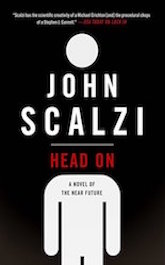In 2014, John Scalzi’s Lock In introduced us to a world drastically changed by Haden Syndrome, a disease that strikes 1% of the population, causing them to become “locked in”: unable to move, but still fully aware of the world around them. The world in Scalzi’s imaginary future adapts to accommodate this population of people. They create programs and infrastructure to allow people with the disease—Hadens—to continue interacting with their family and friends while also creating Haden-specific spaces. The biggest change is the development of mobility robots, called threeps, that allow Hadens to move through the world like the able-bodied.
The main character of the series, Chris Shane, is a Haden as well as an FBI agent. Lock In introduces us to Chris as a brand new agent on a Haden-related murder case. Head On, the follow up to Lock In, brings in the Haden-specific sport Hilketa. Hadens play on teams in specifically designed threeps where the goal is to rip off the head of one random member of each team and score points with it. It’s all fun and games until a Hilketa player is killed on the field. The FBI—Chris and partner Vann—have to puzzle out the reasons behind the death and the panicked response from the fledgling Hilketa league. Was the death a terrible accident or foul play?
Lock In and Head On are fast-paced, entertaining speculative crime thrillers set in the near future. They both extrapolate from our current level of technology and culture to pull us along on a chase to find the resolution to the mystery. But they also use culture in fascinating ways to flesh out the world and make it deeper and more familiar by creating parallels with how we currently interact with technology. Let’s explore some of the ways Scalzi uses current technologies and ideological challenges to inform the world of this compulsively readable series.
Buy the Book


Lock In: A Novel of the Near Future
Tech interfaces. In the series, Hadens are outfitted with neural networks that allow them to access their threeps, as well as a nonphysical community space called the Agora, in which they can carve out personal space with simple or complex programming depending on the effect they wish to achieve. Far from being ‘locked in,’ Hadens are able to use this neural network to expand their access to the physical and digital worlds. They can interact with the world and information in it physically, but they have the ability to process and trade information between themselves and other Hadens wirelessly, in a peer-to-peer file exchange. Their threeps also allow them to look up other people—Haden and non-Haden alike—when they meet and receive an immediate run down of the person’s information. This isn’t so different than how we currently look up new friends and acquaintances on social media.
A great way to look at how Hadens use their threeps is to compare it to our current use of phones. Many of us call them phones even though they are much more; we’re incredibly attached to these powerful pocket computers. We communicate with friends and family via voice, video, and text; we work and play with apps; and we take pictures and record video. Our phones often become an extension of ourselves. Phones are already acting as assistive devices for both abled and disabled populations. There are text to speech features, verbal commands, sign language and self-care apps, and multiple ways to adapt the phone to work for each individual user. Depending on the model, phones are extremely customizable in how they function for each user. Scalzi takes our current smartphone technology and follows it along to potential new avenues of use for the disabled, in this case, Hadens, instead of creating dramatically new technology to serve the story. Lock In and Head On examine our current use of these tiny, external computers and imagines how we might adapt that connection to the world as a mobility aid.
Accessibility. Neither Lock In nor Head On are shy in their critique of how people—in this case, Hadens—are marginalized due to their use of threeps. The series tackles how technology will adapt to mobility issues and access for those who interact differently with physical spaces. In doing so, it also deals with how many spaces don’t adapt. Some factions of the able-bodied population treat them thoughtlessly, which mirrors the way some people treat those using mobility aids now. The able-bodied response to threeps is peppered throughout the stories in the form of the casual micro-aggressions Chris experiences—eerily familiar to anyone who has ever needed a long term mobility aide.
Also, when public accommodation for threeps is bad—Chris has to use different threeps for FBI business, connecting to them remotely—it has an immediate impact on how effectively Chris can navigate the world and do work. Even more incisive is Scalzi’s depiction of how wealth changes the experience of Hadens. The books repeatedly show Chris’s wealth and ability to choose which threeps to use, in contrast to the financial struggles of other Hadens that Chris meets during investigations. Once again, our current cultural context is taken and extrapolated out to see how accessibility issues might change, but also how they might stay the same for both abled and disabled individuals.
Buy the Book


Head On: A Novel of the Near Future (Lock in)
The nature of competition. In the past few decades, games have exploded in popularity, but the way humans play games has changed, too. From tabletop games with digital interaction options to online multiplayer engagement, gaming continues to evolve. As technology has improved, gamers have formed teams and leagues and created viable communities for competition centered around non-physical games. There are organized leagues for science fiction games like Halo; sports games like soccer; and first person shooters like Call of Duty. The games are played in a mix of physical and digital spaces and players have found ways to change what it means to be a competitor. Players have shifted the mental ability and knowledge of systems that gaming requires to a context in which playing a game can be considered an actual sport.
The game in Head On, Hilketa, extrapolates from current gaming culture as sport and ports it into a physical and digital space as a way for Hadens to engage in competition. The game is incredibly physical and allows Hadens to participate in sport in their own context. Given that players don’t use their own bodies, this doesn’t come without controversy. Non-Hadens can’t play Hilketa at the same level, due to how naturally Hadens engage with threeps via their neural networks, and the learning curve for non-Hadens is high. Head On raises a debate about the feasibility of Haden-only Hilketa in the future, and explores what it means for someone who is locked in to be an athlete.
Politics and law. Lock In and Head On are about criminal investigations and how Chris operates within the law to solve cases. But the series also explores changing circumstances of those who rely on government support to afford adequate healthcare, and the realities of what it means to live with an illness that can never be cured. Just as much as the books are about good people trying to find justice, they’re also about how capitalism and socialism can be at odds with each other and create conditions that force people into illegal and unethical situations out of desperation. The people hurt when people abuse social programs— often not the people who need them—are those among us who need the most help.
If you loved Lock In, Head On is a expansive follow-up that deepens the character relationships from its predecessor and expands the world in thoughtful ways with an eye toward imagining toward a realistic future. And best of all, the critiques of culture and excellent banter come with a fun side of robot fights.
Renay Williams stumbled into online fandom, fanfiction, and media criticism via Sailor Moon in 1994. Since then, she’s become an editor at Lady Business and a co-host of Fangirl Happy Hour. She can be found having emotions over the lives of fictional characters on Twitter @renay.










